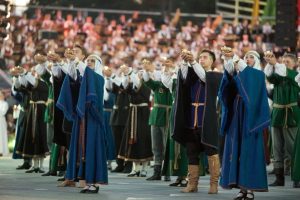Latest news, partnership and traveling updates.
Celebrating a Century of Lithuania’s Singing Tradition
In the year 2024, Lithuania finds itself at the threshold of an extraordinary milestone—the 100th anniversary of the Song Celebration, a cultural marvel that has traversed generations and geographical boundaries. For a century, this revered event has not only been a source of pride for Lithuanians, but it has also captivated audiences worldwide, earning recognition from UNESCO as a Masterpiece of the Oral and Intangible Cultural Heritage of Humanity in 2003.

Green Forest Forever
The Song Celebration spans a week of jubilation, requiring years of meticulous preparation from its participants. The highly anticipated centennial festivity, aptly named Green Forest Forever, is scheduled to unfold from June 29th to July 6th and promises an immersive experience with 14 exceptional events featuring the participation of 37 thousand dedicated performers. With over 1 million enthusiastic spectators expected the festivities pledge to deliver memorable moments.
“We are privileged to organise this historic event, emblematic of one of Lithuania’s most cherished traditions — song,” says Saulius Liausa, Director of Lithuania’s National Culture Centre. He highlights the significance behind the title Green Forest Forever, emphasising Lithuania’s deep connection to nature and traditions. “The idea of a green forest symbolises our nation’s journey through historical challenges, growing as a state and as a community, much like the vibrant growth of a forest, where every tree has its voice. Those voices continue to speak of freedom, creativity, and memory,“ adds Liausa.
Anticipating around 9 thousand performers for Dance Day and approximately 12 thousand singers for Song Day, the centenary celebration promises a vibrant display of cultural pride and unity.
How it all began
It all started in 1924 when the first Song Celebration took root in Kaunas, seamlessly weaving itself into the fabric of Lithuanian cultural identity. Today, these celebrations kick off in Kaunas but sprawl across multiple venues in Vilnius and Kaunas, Lithuania’s largest cities. The tradition of Song Celebrations traces its origins back to the mid-19th century in Switzerland and Germany, a time when amateur choirs flourished. While the festivals in those countries faded into obscurity, the Baltic States stood resilient, safeguarding the tradition as a covert yet powerful weapon against national occupations.
Symbol of resilience and cultural identity
Throughout history, Lithuanians weathered turbulent periods of harsh occupation, finding solace and unity through the transcendent power of song. The Song Celebrations emerged as poignant symbols of resilience, epitomizing an unwavering pursuit of freedom and serving as cradles protecting cultural identity and ancestral traditions.
As the end of the 20th century drew to a close, the people of Lithuania, Latvia, and Estonia challenged the might of the crumbling Soviet Union. The independence movements featured impressive mass rallies that were characterized by spontaneous singing. Today, this historical phenomenon is known as the Singing Revolution. One might therefore say that the tradition of Song and Dance Celebrations has prepared the Baltic nations for their brave struggle to live in freedom.
Celebrating across borders: diaspora’s bond
Beyond Lithuania’s borders, local Song and Dance Celebrations thrive among Lithuanian communities scattered worldwide. During World War II and in its immediate aftermath, a substantial segment of the Lithuanian population either sought refuge in the West or endured deportations to Siberia under the oppressive Soviet regime. Notably, Lithuanian deportees in Igarka (Siberia) organized the first local Song Celebration in 1953, followed by North American Lithuanians in 1956. “New choirs and dance groups are emerging in the diaspora abroad, serving as a vibrant expression of our cultural identity. This is indeed a powerful means of preserving our heritage. Today, anticipation is building for the upcoming Song Celebration – an opportunity to visit Lithuania and connect with fellow enthusiasts, all bound by a shared love for the country.”, says Dalia Henke, the chair of the Lithuanian World Community.
Tough preparation for the celebration
“As soon as one Celebration is over, preparations for the next begin,” explains Saulius Liausa, the Director of Lithuania’s National Culture Centre. Under the guidance of choir conductors and dance instructors, singers, and dancers in every town and village of Lithuania dedicate years of practice to polish their performances for the next national Celebration.
Traditionally spanning a week, the national Song Celebration encompasses several key events that capture the essence of Lithuanian culture. These include Folklore Day, Ensembles’ Evening, Dance Day, and the much-anticipated final event–Song Day at Vingis Park Amphitheatre.
Song and Dance Celebration highlights
The Dance Day, scheduled to take place at Vilnius Football Stadium on July 5th, is expected to feature over 9,000 performers interpreting folk dances that symbolize connections between various realms—earth and sky, past and present, and the fusion of diverse cultures.
The pinnacle of the week, Song Day on July 6th in Vingis Park, is going to attract crowds eager to witness 12,000 performers showcasing a rich repertoire of Lithuanian compositions, blending classical and contemporary pieces. This three-hour program, orchestrated by Lithuanian choirs worldwide, serves as a chronicle, reflecting the evolution of Lithuanian singing culture over time.
Today, Lithuanians are known for their unwavering spirit, exceptional leadership, and inherent resilience. They proudly embrace the responsibility of safeguarding the cherished Song Celebration tradition, diligently passing down this rich legacy to future generations.




